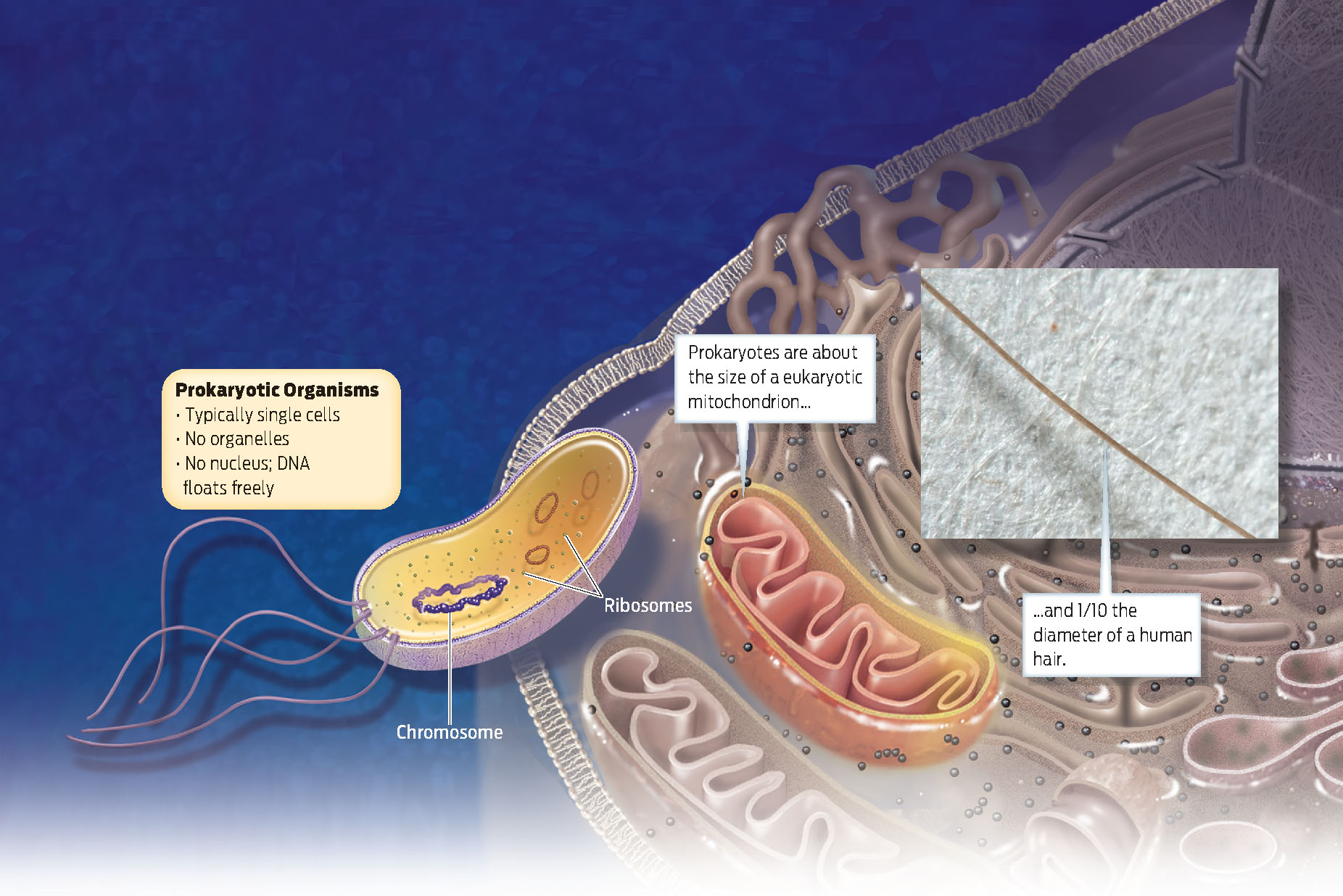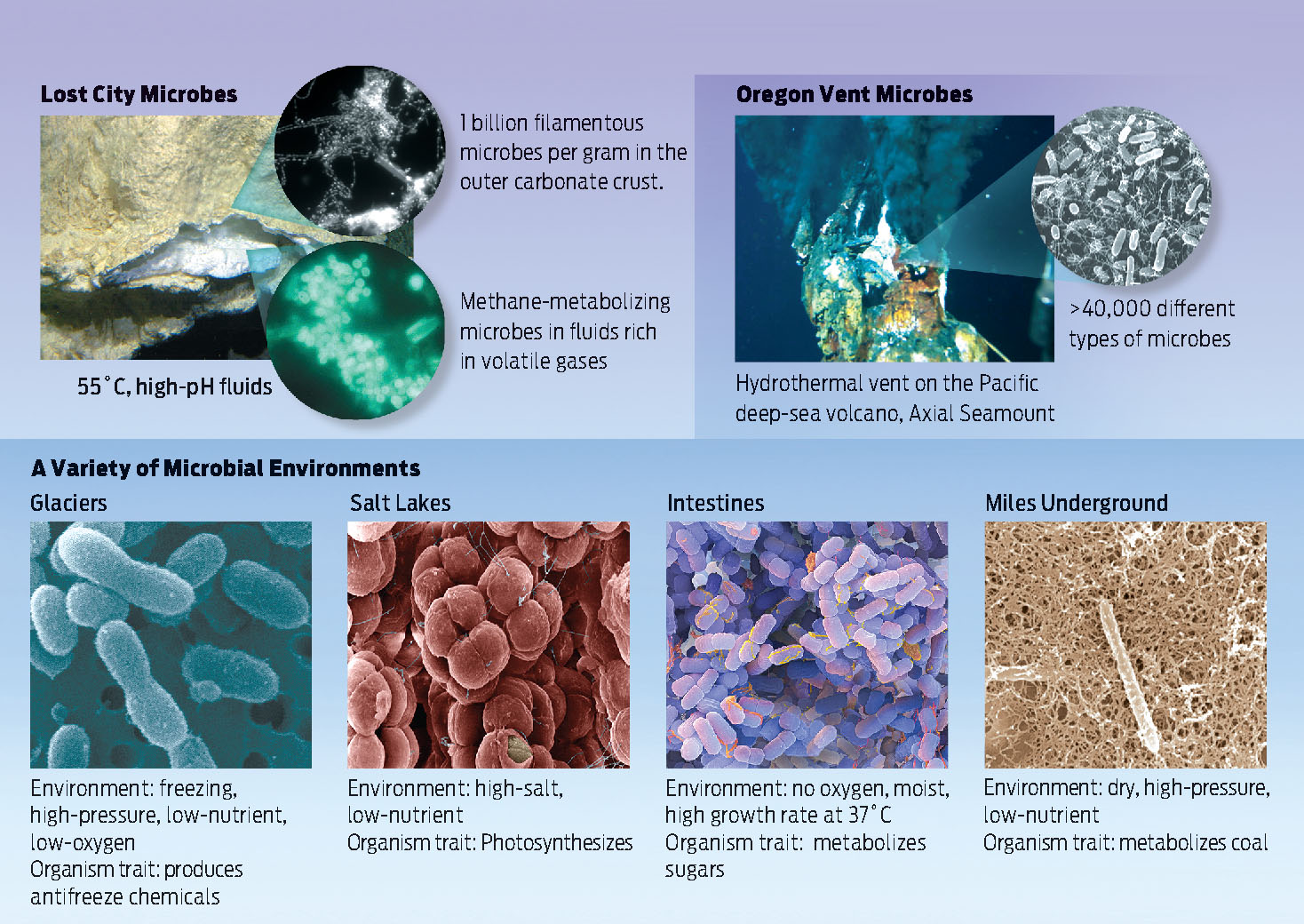What are they?
PROKARYOTE A usually unicellular organism whose cell lacks internal membrane-bound organelles and whose DNA is not contained within a nucleus.
The microbial life in Lost City poses many riddles for the scientists trying to understand this mysterious deep-sea world: What are these creatures? How are they related to known organisms? What adaptations allow them to survive?
Lost City houses a community of life forms ranging from mats of microbes to translucent 1-cm-long animals and the larger fish that eat them. But most of the living things at Lost City are prokaryotes—unicellular organisms whose single cell lacks internal membrane-bound organelles and whose ribbon of DNA floats freely in the cytoplasm (rather than being housed in a nucleus, as in eukaryotes; see Chapter 3). Prokaryotic organisms are microscopic, on the order of 1–10 microns, which is about 1/10 the thickness of a human hair (INFOGRAPHIC 18.3).
Prokaryotic cells are much smaller than eukaryotic cells and do not have the same internal organization. Prokaryotic cells lack organelles, instead carrying out all cellular functions in one central space. The DNA molecule floats freely in the cytoplasm.

What prokaryotes lack in size they make up for in numbers. Prokaryotes occupy virtually every niche on the planet, and most scientists agree that we have barely scratched the surface in cataloguing their numbers and diversity. There are more prokaryotes in a handful of dirt than there are plants and animals in a rain forest. More prokaryotic organisms live on and in you right now than there are human cells in your body. At Lost City, up to 1 billion such prokaryotic organisms inhabit each gram of chimney rock, forming a mucuslike biofilm several centimeters thick. It looks like the chimneys got sneezed on, says Brazelton.
396
As their numbers testify, prokaryotes are an extraordinarily successful product of evolution. From fossil evidence, we know that prokaryotes were the first colonizers of our planet, and for nearly 2 billion years its only life form. Having first evolved nearly 4 billion years ago, prokaryotic organisms have had plenty of time to adapt to a wide range of environments, including many that would kill most eukaryotes. In fact, prokaryotes can thrive just about anywhere. At another type of deep-sea hydrothermal vent, off the Oregon coast—one with very acidic, extremely hot fluids—scientists have discovered more than 40,000 different kinds of prokaryote (INFOGRAPHIC 18.4).
Even in seemingly inhospitable environments, there can be large numbers and many different types of prokaryotic microorganism.

How do the prokaryotic organisms found at Lost City compare to those living elsewhere? When biologists want to identify a prokaryote, they can’t always rely on physical appearance, since many prokaryotic organisms look similar under a microscope. Nor can prokaryotes necessarily be grown in the laboratory. Many of the unusual prokaryotes at Lost City were almost impossible to culture in the lab, making it hard to study their features and behavior. Instead, biologists generally rely on DNA to identify prokaryotic organisms. The number of DNA sequence similarities between the new species and known ones establishes their degree of relatedness. Finding a unique DNA sequence in a sample means the researchers have discovered a new organism.
By looking at DNA sequences, researchers have discovered several new species of prokaryotic organisms living at Lost City. Two of these species fall into a group of prokaryotes known as archaea. Archaea aren’t the only prokaryotes present at Lost City—the site is rich in bacterial populations, too—but it’s the archaea that are most interesting to researchers. That’s because the archaea are doing things that even bacteria can’t do.
397
At Lost City, bacterial populations congregate on the outsides of the active vents, where temperatures are relatively mild and where oxygen is present in the seawater. Archaea, by contrast, are found inside the vents, where temperatures are hottest and where there is no oxygen. So far, just two species of archaea have been detected in this environment. “The conditions are so extreme that they’re the only thing that has been able to survive,” says Brazelton. Because of their preference for such extreme environments, archaea have been nicknamed “extremophiles.”
As intriguing as these extreme-loving organisms are, however, they weren’t even recognized as a distinct evolutionary group until quite recently. For many years all prokaryotes were lumped together into one large group—the kingdom Monera—a classification based largely on their cell structure. Then, in the late 1970s, Carl Woese and his colleagues at the University of Illinois made the surprising discovery that not all prokaryotic organisms are genetically similar enough to be classified as a single group. His work established an entirely new branch of prokaryotic organisms, now known as the archaea. While most archaea don’t look that different from bacteria under the microscope—both are unicellular prokaryotes—genetically they are as different from bacteria as humans are. In other words, they represent a distinct evolutionary domain of life. Together, the domains Bacteria and Archaea represent a very large slice of the total diversity of life on Earth (INFOGRAPHIC 18.5).
Two of the domains of life, Bacteria and Archaea, have prokaryotic cells, but each has a distinct evolutionary history, with Archaea being genetically closer to Eukarya than to Bacteria. The genetic differences between Bacteria and Archaea translate into a variety of structural and functional adaptations.

398